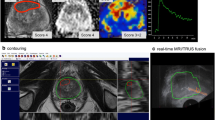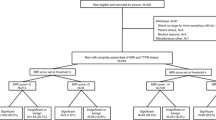Abstract
Objectives
To evaluate the Prostate Imaging Reporting and Data System (PI-RADS) proposed by the European Society of Urogenital Radiology (ESUR) for detection of prostate cancer (PCa) by multiparametric magnetic resonance imaging (mpMRI) in a consecutive cohort of patients with magnetic resonance/transrectal ultrasound (MR/TRUS) fusion-guided biopsy.
Methods
Suspicious lesions on mpMRI at 3.0 T were scored according to the PI-RADS system before MR/TRUS fusion-guided biopsy and correlated to histopathology results. Statistical correlation was obtained by a Mann–Whitney U test. Receiver operating characteristics (ROC) and optimal thresholds were calculated.
Results
In 64 patients, 128/445 positive biopsy cores were obtained out of 95 suspicious regions of interest (ROIs). PCa was present in 27/64 (42 %) of the patients. ROC results for the aggregated PI-RADS scores exhibited higher areas under the curve compared to those of the Likert score. Sensitivity/specificity for the following thresholds were calculated: 73 %/92 % and 85 %/67 % for PI-RADS scores of 9 and 10, respectively; 85 %/56 % and 60 %/97 % for Likert scores of 3 and 4, respectively.
Conclusions
The standardised ESUR PI-RADS system is beneficial to indicate the likelihood of PCa of suspicious lesions on mpMRI. It is also valuable to identify locations to be targeted with biopsy. The aggregated PI-RADS score achieved better results compared to the single five-point Likert score.
Key points
• The ESUR PI-RADS scoring system was evaluated using multiparametric 3.0-T MRI.
• To investigate suspicious findings, transperineal MR/TRUS fusion-guided biopsy was used.
• PI-RADS can guide biopsy locations and improve detection of clinically significant cancer.
• Biopsy procedures can be optimised, reducing unnecessary negative biopsies for patients.
• The PI-RADS scoring system may contribute to more effective prostate MRI.



Similar content being viewed by others
Abbreviations
- ADC:
-
apparent diffusion coefficient
- BI-RADS:
-
Breast Imaging Reporting and Data System
- CI:
-
confidence interval
- DCE:
-
dynamic contrast enhanced
- DICOM:
-
Digital Imaging and Communication in Medicine
- DRE:
-
digital rectal examination
- DWI:
-
diffusion-weighted imaging
- ESUR:
-
European Society of Urogenital Radiology
- HASTE:
-
half-Fourier acquisition turbo spin echo
- MRI:
-
magnetic resonance imaging
- MRS:
-
magnetic resonance spectroscopy
- PCa:
-
prostate cancer
- PI-RADS:
-
Prostate Imaging Reporting and Data System
- PSA:
-
prostate specific antigen
- ROC:
-
receiver operating characteristic
- T1w:
-
T1-weighted
- T2w:
-
T2-weighted
- TRUS:
-
transrectal ultrasound
References
Ahmed HU, Kirkham A, Arya M et al (2009) Is it time to consider a role for MRI before prostate biopsy? Nat Rev Clin Oncol 6:197–206
Heidenreich A, Bellmunt J, Bolla M et al (2011) EAU guidelines on prostate cancer. Part 1: screening, diagnosis, and treatment of clinically localised disease. Eur Urol 59:61–71
Kirkham AP, Emberton M, Allen C (2006) How good is MRI at detecting and characterising cancer within the prostate? Eur Urol 50:1163–1174
Dickinson L, Ahmed HU, Allen C et al (2011) Magnetic resonance imaging for the detection, localisation, and characterisation of prostate cancer: recommendations from a European consensus meeting. Eur Urol 59:477–494
Hoeks CM, Barentsz JO, Hambrock T et al (2011) Prostate cancer: multiparametric MR imaging for detection, localization, and staging. Radiology 261:46–66
Dickinson L, Ahmed HU, Allen C et al (2013) Scoring systems used for the interpretation and reporting of multiparametric MRI for prostate cancer detection, localization, and characterization: could standardization lead to improved utilization of imaging within the diagnostic pathway? J Magn Reson Imaging 37:48–58
Barentsz JO, Richenberg J, Clements R et al (2012) ESUR prostate MR guidelines 2012. Eur Radiol 22:746–757
Molleran V, Mahoney MC (2010) The BI-RADS breast magnetic resonance imaging lexicon. Magn Reson Imaging Clin N Am 18:171–185
Portalez D, Rollin G, Leandri P et al (2010) Prospective comparison of T2w-MRI and dynamic-contrast-enhanced MRI, 3D-MR spectroscopic imaging or diffusion-weighted MRI in repeat TRUS-guided biopsies. Eur Radiol 20:2781–2790
Schimmöller L, Quentin M, Arsov C et al (2013) Inter-reader agreement of the ESUR score for prostate MRI using in-bore MRI-guided biopsies as the reference standard. Eur Radiol. doi:10.1007/s00330-013-2922-y
Roethke M, Blondin D, Schlemmer HP, Franiel T (2013) PI-RADS classification: structured reporting for MRI of the prostate. Rofo 185:253–261
Hadaschik BA, Kuru TH, Tulea C et al (2011) A novel stereotactic prostate biopsy system integrating pre-interventional magnetic resonance imaging and live ultrasound fusion. J Urol 186:2214–2220
Kuru TH, Roethke M, Popeneciu V et al (2012) Phantom study of a novel stereotactic prostate biopsy system integrating preinterventional magnetic resonance imaging and live ultrasonography fusion. J Endourol 26:807–813
Vargas HA, Akin O, Shukla-Dave A et al (2012) Performance characteristics of MR imaging in the evaluation of clinically low-risk prostate cancer: a prospective study. Radiology 265:478–487
Weinreb JC, Blume JD, Coakley FV et al (2009) Prostate cancer: sextant localization at MR imaging and MR spectroscopic imaging before prostatectomy–results of ACRIN prospective multi-institutional clinicopathologic study. Radiology 251:122–133
Futterer JJ, Engelbrecht MR, Jager GJ et al (2007) Prostate cancer: comparison of local staging accuracy of pelvic phased-array coil alone versus integrated endorectal-pelvic phased-array coils. Local staging accuracy of prostate cancer using endorectal coil MR imaging. Eur Radiol 17:1055–1065
Lee SH, Park KK, Choi KH et al (2010) Is endorectal coil necessary for the staging of clinically localized prostate cancer? Comparison of non-endorectal versus endorectal MR imaging. World J Urol 28:667–672
Park BK, Kim B, Kim CK, Lee HM, Kwon GY (2007) Comparison of phased-array 3.0-T and endorectal 1.5-T magnetic resonance imaging in the evaluation of local staging accuracy for prostate cancer. J Comput Assist Tomogr 31:534–538
Scheenen TW, Heijmink SW, Roell SA et al (2007) Three-dimensional proton MR spectroscopy of human prostate at 3 T without endorectal coil: feasibility. Radiology 245:507–516
Klotz L (2012) Active surveillance for favorable-risk prostate cancer: background, patient selection, triggers for intervention, and outcomes. Curr Urol Rep 13:153–159
Rosenkrantz AB, Kim S, Lim RP et al (2013) Prostate cancer localization using multiparametric MR imaging: comparison of Prostate Imaging Reporting and Data System (PI-RADS) and Likert scales. Radiology. doi:10.1148/radiol.13122233
Harnden P, Naylor B, Shelley MD, Clements H, Coles B, Mason MD (2008) The clinical management of patients with a small volume of prostatic cancer on biopsy: what are the risks of progression? A systematic review and meta-analysis. Cancer 112:971–981
Ahmed HU, Hu Y, Carter T et al (2011) Characterizing clinically significant prostate cancer using template prostate map** biopsy. J Urol 186:458–464
Roethke M, Anastasiadis AG, Lichy M et al (2012) MRI-guided prostate biopsy detects clinically significant cancer: analysis of a cohort of 100 patients after previous negative TRUS biopsy. World J Urol 30:213–218
Vargas HA, Akin O, Afaq A et al (2012) Magnetic resonance imaging for predicting prostate biopsy findings in patients considered for active surveillance of clinically low risk prostate cancer. J Urol 188:1732–173826
Anastasiadis AG, Lichy MP, Nagele U et al (2006) MRI-guided biopsy of the prostate increases diagnostic performance in men with elevated or increasing PSA levels after previous negative TRUS biopsies. Eur Urol 50:738–748
Pinto PA, Chung PH, Rastinehad AR et al (2011) Magnetic resonance imaging/ultrasound fusion guided prostate biopsy improves cancer detection following transrectal ultrasound biopsy and correlates with multiparametric magnetic resonance imaging. J Urol 186:1281–1285
Ukimura O, Desai MM, Palmer S et al (2012) 3-Dimensional elastic registration system of prostate biopsy location by real-time 3-dimensional transrectal ultrasound guidance with magnetic resonance/transrectal ultrasound image fusion. J Urol 187:1080–1086
Baumann M, Mozer P, Daanen V, Troccaz J (2012) Prostate biopsy tracking with deformation estimation. Med Image Anal 16:562–576
Kasivisvanathan V, Dufour R, Moore CM et al (2013) Transperineal magnetic resonance image targeted prostate biopsy versus transperineal template prostate biopsy in the detection of clinically significant prostate cancer. J Urol 189:860–866
Author information
Authors and Affiliations
Corresponding author
Rights and permissions
About this article
Cite this article
Roethke, M.C., Kuru, T.H., Schultze, S. et al. Evaluation of the ESUR PI-RADS scoring system for multiparametric MRI of the prostate with targeted MR/TRUS fusion-guided biopsy at 3.0 Tesla. Eur Radiol 24, 344–352 (2014). https://doi.org/10.1007/s00330-013-3017-5
Received:
Revised:
Accepted:
Published:
Issue Date:
DOI: https://doi.org/10.1007/s00330-013-3017-5




